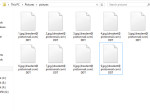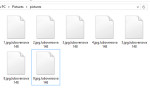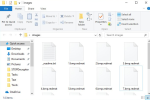Unlock Files – MUSLAT Ransomware
 MUSLAT Ransomware is categorized as ransomware, a file-encrypting kind of malicious program. It's not a minor infection since it could leave your data permanently encrypted. Additionally, infecting your system is very easy, therefore making data encrypting malware one of the most harmful malicious software out there. If you have recently opened a strange email attachment, clicked on a dubious advert or downloaded an 'update' promoted on some shady web page, that is how it contaminated your system. After data is successfully encrypted, it will ask that you pay a ransom for a for a way to decrypt files. The sum you are requested to pay will possibly differ depending on the type of data encoding malicious software has infiltrated your device, but should range from $50 to possibly thousands of dollars. Whether you are requested for a lot of money, or a insignificant amount, giving into the demands is not recommended. Take into account that these are criminals you are dealing with and they can simply take your money giving nothing in return. If you take the time to look into it, you'll certainly find accounts of users not recovering files, even after paying. It would be a better idea to get backup with that money. There are plenty of options, and we are certain you'll find one best matching your needs. If you had backup prior to infection, file restoration will be possible after you uninstall MUSLAT Ransomware. You will happen upon malware like this all over, and you will possibly get infected again, so you have to be prepared for it. In order to protect a system, one should always be on the lookout for possible threats, becoming familiar with their spread methods.
Read more...
MUSLAT Ransomware is categorized as ransomware, a file-encrypting kind of malicious program. It's not a minor infection since it could leave your data permanently encrypted. Additionally, infecting your system is very easy, therefore making data encrypting malware one of the most harmful malicious software out there. If you have recently opened a strange email attachment, clicked on a dubious advert or downloaded an 'update' promoted on some shady web page, that is how it contaminated your system. After data is successfully encrypted, it will ask that you pay a ransom for a for a way to decrypt files. The sum you are requested to pay will possibly differ depending on the type of data encoding malicious software has infiltrated your device, but should range from $50 to possibly thousands of dollars. Whether you are requested for a lot of money, or a insignificant amount, giving into the demands is not recommended. Take into account that these are criminals you are dealing with and they can simply take your money giving nothing in return. If you take the time to look into it, you'll certainly find accounts of users not recovering files, even after paying. It would be a better idea to get backup with that money. There are plenty of options, and we are certain you'll find one best matching your needs. If you had backup prior to infection, file restoration will be possible after you uninstall MUSLAT Ransomware. You will happen upon malware like this all over, and you will possibly get infected again, so you have to be prepared for it. In order to protect a system, one should always be on the lookout for possible threats, becoming familiar with their spread methods.
Read more...
[restdoc@protonmail.com].ZOH Ransomware – Unlock Files
 [restdoc@protonmail.com].ZOH Ransomware is a file-encrypting malware, but the categorization you likely have heard before is ransomware. It is possible you've never ran into ransomware before, in which case, you may be particularly surprised. Data encrypting malware tends to use powerful encryption algorithms for the encryption process, which stops you from accessing them any longer. Because file decryption isn't always possible, not to mention the effort it takes to get everything back in order, ransomware is thought to be one of the most dangerous malicious program you may encounter. You do have the option of paying the ransom to get a decryptor, but That isn't recommended. Giving into the requests won't necessarily ensure that you'll get your files back, so expect that you may just be wasting your money. There is nothing preventing cyber criminals from just taking your money, and not giving anything in exchange. In addition, by paying you'd be financing the crooks' future projects. Do you actually want to support something that does many millions of dollars in damage. People are also becoming increasingly attracted to the industry because the amount of people who give into the demands make file encoding malicious program very profitable. Consider investing that requested money into backup instead because you could be put in a situation where file loss is a risk again. You could then restore files from backup after you eliminate [restdoc@protonmail.com].ZOH Ransomware or similar threats. If you have not ran into ransomware before, it's also possible you do not know how it managed to get into your computer, in which case you should cautiously read the following paragraph. Read more...
[restdoc@protonmail.com].ZOH Ransomware is a file-encrypting malware, but the categorization you likely have heard before is ransomware. It is possible you've never ran into ransomware before, in which case, you may be particularly surprised. Data encrypting malware tends to use powerful encryption algorithms for the encryption process, which stops you from accessing them any longer. Because file decryption isn't always possible, not to mention the effort it takes to get everything back in order, ransomware is thought to be one of the most dangerous malicious program you may encounter. You do have the option of paying the ransom to get a decryptor, but That isn't recommended. Giving into the requests won't necessarily ensure that you'll get your files back, so expect that you may just be wasting your money. There is nothing preventing cyber criminals from just taking your money, and not giving anything in exchange. In addition, by paying you'd be financing the crooks' future projects. Do you actually want to support something that does many millions of dollars in damage. People are also becoming increasingly attracted to the industry because the amount of people who give into the demands make file encoding malicious program very profitable. Consider investing that requested money into backup instead because you could be put in a situation where file loss is a risk again. You could then restore files from backup after you eliminate [restdoc@protonmail.com].ZOH Ransomware or similar threats. If you have not ran into ransomware before, it's also possible you do not know how it managed to get into your computer, in which case you should cautiously read the following paragraph. Read more...
{dresdent@protonmail.com}DDT Ransomware Removal
 {dresdent@protonmail.com}DDT Ransomware will immediately begin encoding your files, since it's ransomware. It is not a minor threat since it could leave your data encrypted for good. What's worse is that it is very easy to contaminate your system. If you have it, a spam email attachment, a malicious ad or a bogus download is responsible. Once a computer is infected, the encryption process will be performed, and once it is completed, cyber crooks will demand that you give money in exchange for a way to decode files. Depending on which ransomware has contaminated your system, the money demanded will differ. Paying isn't something you should do, so consider all scenarios. Don't trust crooks to keep their word and recover your data, because they may just take your money. If you're left with still encrypted files after paying, we would not be shocked. This could easily happen again, so consider investing into backup, instead of complying with the requests. Many backup options are available for you, you just have to pick the right one. You can restore files from backup if you had it done prior to infection, after you delete {dresdent@protonmail.com}DDT Ransomware. Malware like this is lurking everywhere, and you will possibly get infected again, so you need to be prepared for it. If you wish your machine to not be infected constantly, it is crucial to learn about malicious software and how it could get into your system.
Read more...
{dresdent@protonmail.com}DDT Ransomware will immediately begin encoding your files, since it's ransomware. It is not a minor threat since it could leave your data encrypted for good. What's worse is that it is very easy to contaminate your system. If you have it, a spam email attachment, a malicious ad or a bogus download is responsible. Once a computer is infected, the encryption process will be performed, and once it is completed, cyber crooks will demand that you give money in exchange for a way to decode files. Depending on which ransomware has contaminated your system, the money demanded will differ. Paying isn't something you should do, so consider all scenarios. Don't trust crooks to keep their word and recover your data, because they may just take your money. If you're left with still encrypted files after paying, we would not be shocked. This could easily happen again, so consider investing into backup, instead of complying with the requests. Many backup options are available for you, you just have to pick the right one. You can restore files from backup if you had it done prior to infection, after you delete {dresdent@protonmail.com}DDT Ransomware. Malware like this is lurking everywhere, and you will possibly get infected again, so you need to be prepared for it. If you wish your machine to not be infected constantly, it is crucial to learn about malicious software and how it could get into your system.
Read more...
Luboversova148 Ransomware Removal
 Luboversova148 Ransomware will encrypt your files, which is why it is an infection you definitely want to avoid. Ransomware is how this kind of malware is usually referred to. There are a couple of ways you may have obtained the threat, possibly either through spam email attachments, malicious adverts or downloads from dubious sources. This will be further discussed in a further paragraph. A ransomware infection could lead to very serious outcomes, so you must be aware of how you could prevent it from slipping in. If you haven't come across file-encrypting type of malware before, it may be especially troublesome to find all your files locked. A ransom message ought to appear soon after the files become locked, and it will explain that you must pay money to decrypt your files. It is very unlikely that you will receive a decryptor after you pay, because you are dealing with criminals, who will not feel accountability to help you. The hackers will likely just ignore you after you make the payment, and it's not likely that they will even attempt to help you. You should also consider where the money would be going, it will probably support other malware. In certain cases, malware specialists can crack the ransomware, and might release a free decryption tool. Before rushing to give into the demands, research that. And if you had backed up your files before, after you delete Luboversova148 Ransomware, you can access them there.
Read more...
Luboversova148 Ransomware will encrypt your files, which is why it is an infection you definitely want to avoid. Ransomware is how this kind of malware is usually referred to. There are a couple of ways you may have obtained the threat, possibly either through spam email attachments, malicious adverts or downloads from dubious sources. This will be further discussed in a further paragraph. A ransomware infection could lead to very serious outcomes, so you must be aware of how you could prevent it from slipping in. If you haven't come across file-encrypting type of malware before, it may be especially troublesome to find all your files locked. A ransom message ought to appear soon after the files become locked, and it will explain that you must pay money to decrypt your files. It is very unlikely that you will receive a decryptor after you pay, because you are dealing with criminals, who will not feel accountability to help you. The hackers will likely just ignore you after you make the payment, and it's not likely that they will even attempt to help you. You should also consider where the money would be going, it will probably support other malware. In certain cases, malware specialists can crack the ransomware, and might release a free decryption tool. Before rushing to give into the demands, research that. And if you had backed up your files before, after you delete Luboversova148 Ransomware, you can access them there.
Read more...
Davda Ransomware Removal
 Davda Ransomware file-encoding malware, generally known as ransomware, will encrypt your data. Infection could have severe consequences, as encoded data could be permanently inaccessible. Also it's very easy to contaminate your device. Data encrypting malicious program developers target hasty users, as infection usually occurs by opening a malicious email attachment, clicking on a malicious advert or falling for bogus 'downloads'. After it encodes your data, it will ask that you pay a specific amount of money for a decryptor. $50 or $1000 may be asked of you, depending on which ransomware you have. Whatever you are demanded to pay by this threat, think about every likely outcome before you do. Who is going to stop crooks from simply taking your money, providing nothing in return. If you take the time to look into it, you'll definitely find accounts of people not recovering data, even after paying. Research backup options, so that if this were to happen again, you wouldn't risk losing your data. While you will be given a lot of different options, it shouldn't be hard to find the best option for you. If backup is available, recovering data won't be a problem. It is crucial that you prepare for all scenarios in these types of situations because you'll probably get infected again. To keep a device safe, one must always be on the lookout for possible threats, becoming familiar with how to avoid them.
Read more...
Davda Ransomware file-encoding malware, generally known as ransomware, will encrypt your data. Infection could have severe consequences, as encoded data could be permanently inaccessible. Also it's very easy to contaminate your device. Data encrypting malicious program developers target hasty users, as infection usually occurs by opening a malicious email attachment, clicking on a malicious advert or falling for bogus 'downloads'. After it encodes your data, it will ask that you pay a specific amount of money for a decryptor. $50 or $1000 may be asked of you, depending on which ransomware you have. Whatever you are demanded to pay by this threat, think about every likely outcome before you do. Who is going to stop crooks from simply taking your money, providing nothing in return. If you take the time to look into it, you'll definitely find accounts of people not recovering data, even after paying. Research backup options, so that if this were to happen again, you wouldn't risk losing your data. While you will be given a lot of different options, it shouldn't be hard to find the best option for you. If backup is available, recovering data won't be a problem. It is crucial that you prepare for all scenarios in these types of situations because you'll probably get infected again. To keep a device safe, one must always be on the lookout for possible threats, becoming familiar with how to avoid them.
Read more...
Lanset Ransomware Removal
 Lanset ransomware file encrypting malware will lock your files and they will be unopenable. It's more widely referred to as ransomware. There is a high possibility that you recently opened a malicious attachment or downloaded from malicious sources, and that is how the infection got in. By continuing to read the article, you'll find more details on how infection might be avoided. A file-encrypting malware infection may result in dire consequences, thus it is very crucial that you know about its spread ways. If you are not familiar with ransomware, it may be rather surprising to see encrypted files. A ransom note should appear soon after the files are encrypted, and it'll explain that you must pay money in exchange for a decryption program. Remember who you're dealing with if you consider paying the ransom, because we doubt crooks will bother to send you a decryption software. It's quite likely that you will not get assistance from them. We'd also like to point out that the money will probably finance more malware. There's a likelihood that a free decryption utility has been released, as people specializing in malicious software sometimes are able to crack the ransomware. Before you rush to give into the demands, research that. Recovering files should be easy if backup was made prior to the ransomware getting in, so simply terminate Lanset ransomware and restore files.
Read more...
Lanset ransomware file encrypting malware will lock your files and they will be unopenable. It's more widely referred to as ransomware. There is a high possibility that you recently opened a malicious attachment or downloaded from malicious sources, and that is how the infection got in. By continuing to read the article, you'll find more details on how infection might be avoided. A file-encrypting malware infection may result in dire consequences, thus it is very crucial that you know about its spread ways. If you are not familiar with ransomware, it may be rather surprising to see encrypted files. A ransom note should appear soon after the files are encrypted, and it'll explain that you must pay money in exchange for a decryption program. Remember who you're dealing with if you consider paying the ransom, because we doubt crooks will bother to send you a decryption software. It's quite likely that you will not get assistance from them. We'd also like to point out that the money will probably finance more malware. There's a likelihood that a free decryption utility has been released, as people specializing in malicious software sometimes are able to crack the ransomware. Before you rush to give into the demands, research that. Recovering files should be easy if backup was made prior to the ransomware getting in, so simply terminate Lanset ransomware and restore files.
Read more...
How to remove .Redmat file virus
 .Redmat file virus is a file-encrypting malware, known as ransomware in short. If ransomware was unfamiliar to you until now, you are in for a surprise. Powerful encryption algorithms are used by ransomware for data encryption, and once they're locked, you won't be able to open them. This is why file encrypting malicious software is classified as harmful malicious software, seeing as infection may lead to your files being encrypted permanently. Criminals will give you the option of decrypting files by paying the ransom, but that is not a encouraged option for a couple of reasons. Paying will not necessarily ensure that you will get your data back, so there is a possibility that you might just be spending your money on nothing. Consider what's preventing crooks from just taking your money. The cyber crooks' future activities would also be financed by that money. Do you actually want to support an industry that costs billions of dollars to businesses in damage. And the more people give them money, the more of a profitable business ransomware becomes, and that attracts many people to the industry. Buying backup with the requested money would be better because if you are ever put in this type of situation again, you could just recover files from backup and not worry about losing them. You could then just erase .Redmat file virus and recover data. If you didn't know what ransomware is, you may not know how it managed to infect your system, in which case carefully read the below paragraph. Read more...
.Redmat file virus is a file-encrypting malware, known as ransomware in short. If ransomware was unfamiliar to you until now, you are in for a surprise. Powerful encryption algorithms are used by ransomware for data encryption, and once they're locked, you won't be able to open them. This is why file encrypting malicious software is classified as harmful malicious software, seeing as infection may lead to your files being encrypted permanently. Criminals will give you the option of decrypting files by paying the ransom, but that is not a encouraged option for a couple of reasons. Paying will not necessarily ensure that you will get your data back, so there is a possibility that you might just be spending your money on nothing. Consider what's preventing crooks from just taking your money. The cyber crooks' future activities would also be financed by that money. Do you actually want to support an industry that costs billions of dollars to businesses in damage. And the more people give them money, the more of a profitable business ransomware becomes, and that attracts many people to the industry. Buying backup with the requested money would be better because if you are ever put in this type of situation again, you could just recover files from backup and not worry about losing them. You could then just erase .Redmat file virus and recover data. If you didn't know what ransomware is, you may not know how it managed to infect your system, in which case carefully read the below paragraph. Read more...